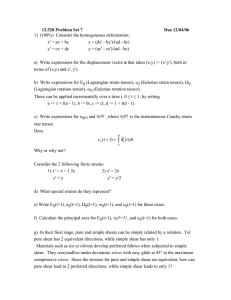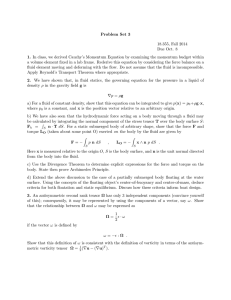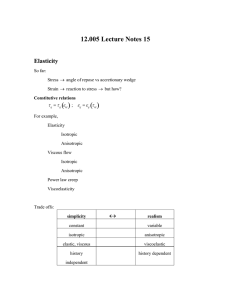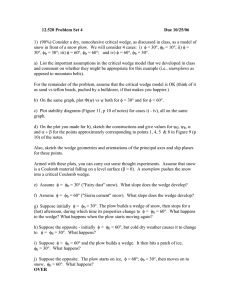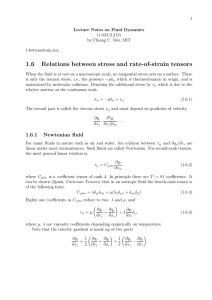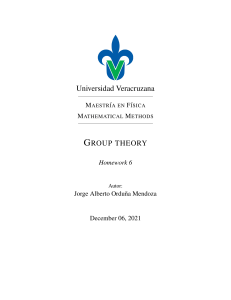1.2 Kinematics of Fluid Motion -the Eulerian picture
advertisement
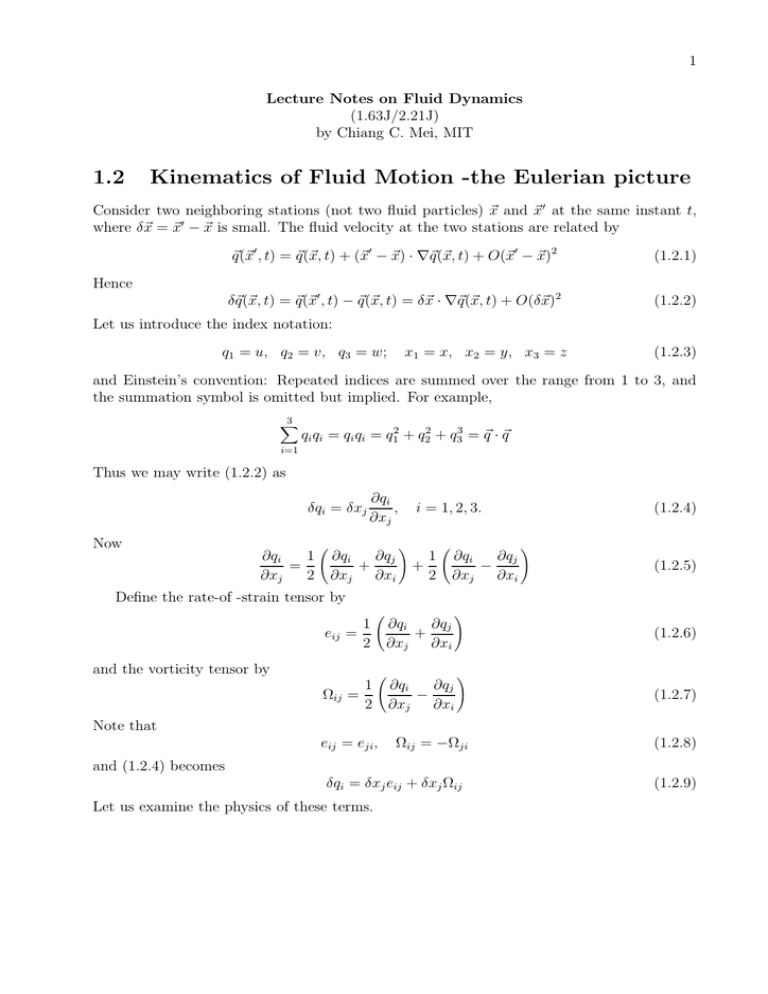
1
Lecture Notes on Fluid Dynamics
(1.63J/2.21J)
by Chiang C. Mei, MIT
1.2
Kinematics of Fluid Motion -the Eulerian picture
Consider two neighboring stations (not two fluid particles) ~x and ~x0 at the same instant t,
where δ~x = ~x0 − ~x is small. The fluid velocity at the two stations are related by
q~(~x0 , t) = ~q(~x, t) + (~x0 − ~x) · ∇~q(~x, t) + O(~x0 − ~x)2
(1.2.1)
δ~q(~x, t) = ~q(~x0 , t) − ~q(~x, t) = δ~x · ∇~q(~x, t) + O(δ~x)2
(1.2.2)
Hence
Let us introduce the index notation:
q1 = u, q2 = v, q3 = w;
x1 = x, x2 = y, x3 = z
(1.2.3)
and Einstein’s convention: Repeated indices are summed over the range from 1 to 3, and
the summation symbol is omitted but implied. For example,
3
X
qi qi = qi qi = q12 + q22 + q33 = ~q · q~
i=1
Thus we may write (1.2.2) as
δqi = δxj
Now
∂qi
1
=
∂xj
2
∂qi
,
∂xj
∂qi
∂qj
+
∂xj ∂xi
i = 1, 2, 3.
!
1
+
2
∂qi
∂qj
−
∂xj
∂xi
(1.2.4)
!
(1.2.5)
Define the rate-of -strain tensor by
1
eij =
2
∂qi
∂qj
+
∂xj ∂xi
!
(1.2.6)
1
Ωij =
2
∂qi
∂qj
−
∂xj
∂xi
!
(1.2.7)
Ωij = −Ωji
(1.2.8)
and the vorticity tensor by
Note that
eij = eji ,
and (1.2.4) becomes
δqi = δxj eij + δxj Ωij
Let us examine the physics of these terms.
(1.2.9)
2
1.2.1
Rate-of-strain tensor
In matrix form, the rate-of -strain tensor is :
e11 e12 e13
{eij } = e21 e22 e23
e31 e32 e33
∂q1
∂x1
=
1
2
1
2
1
2
1
2
∂u
∂x
∂v
+
∂x
∂w
+
∂x
=
∂q2
∂x1
∂q3
∂x1
+
+
∂q1
∂x2 ∂q1
∂x3
∂u
∂y ∂u
∂z
∂q1
+
∂x2
∂q2
∂x2
1 ∂q3
+
2 ∂x2
1
2
∂u
+
∂y
∂v
∂y
1 ∂w
+
2 ∂y
1
2
∂q2
∂x1
∂q2
∂x3
∂v
∂x
∂v
∂z
1
2
1
2
1
2
1
2
∂q1
+
∂x3
∂q2
+
∂x3
∂q3
∂x3
∂u
+
∂z
∂v
+
∂z
∂w
∂z
∂q3
∂x1 ∂q3
∂x2
∂w
∂x ∂w
∂y
(1.2.10)
First, the diagonal terms. It is easy to see that e11 = ∂u/∂x is the rate of stretching per
unit length in the direction of x, e22 = ∂v/∂y is the rate of stretching per unit length in the
direction of y, and e33 = ∂w/∂z is the rate of stretching per unit length in the direction of
z. They are the normal components of the rate of strain tensor.
Note that
∂u ∂v ∂w
e11 + e22 + e33 = ekk =
+
+
= ∇ · q~
(1.2.11)
∂x ∂y
∂z
is the rate of volume dilatation due to fluid motion. For a proof, let us consider a cube with
sides (x, x + ∆x), (y, y + ∆y)
and (z,z + ∆z). After δt, the side along x will lengthen from
∂u
∆x to ∆x + ∆x ∂x δt = ∆x 1 + ∂u
δt . Similarly, the side along y will lengthen from ∆y to
∂x
∆y 1 + ∂v
δt , and the side along z lengthens from ∆z to ∆z 1 +
∂y
volume V (t) = ∆x∆y∆z will change to
!
∂w
δt
∂z
. Consequently the
!
∂u
∂v
∂w
δt ∆y 1 +
δt ∆z 1 +
δt
V (t + δt) = ∆x 1 +
∂x
∂y
∂z
"
!
∂u ∂v ∂w
= V (t) 1 +
+
+
δt + O(δt)2
∂x ∂y
∂z
Hence, the rate of volume dilatation is
1 V (t + δt) − V (t)
1 dV
=
=
lim
δt=0 V
δt
V dt
∂u ∂v ∂w
+
+
∂x ∂y
∂z
!
!
#
= ∇ · ~q
(1.2.12)
Next, the off-diagonal terms. Referring to Figure 1.2.1, consider a plane flow in which ∂u
∂y
∂v
do not vanish. In the time interval δt the side ∆x rotates counterclockwise for an angle
and ∂x
∂v
δθ1 = ∆vδt
= ∂x
δt. The side ∆y rotates counterclockwise for an angle δθ2 = − ∆uδt
= − ∂u
∆t.
∆x
∆y
∂y
The total rate of angular deformation is
δθ1 δθ2
∂v ∂u
−
=
+
δt
δt
∂x ∂y
(1.2.13)
3
Figure 1.2.1: Rate of strain tensor components
Thus e12 = exy is a rate of angular deformation, called the rate of shear strain. Other
components e13 and e23 can be interpreted similarly.
1.2.2
Vorticity tensor
The matrix form of Ωij is
Ω11 Ω12 Ω13
{Ωij } = Ω21 Ω22 Ω23
Ω31 Ω32 Ω33
=
1
2
0
1
2
1
2
∂q2
∂x1
∂q3
∂x1
0
1 ∂v
= 2 ∂x −
1
2
∂w
∂x
∂q1
∂x2 ∂q1
∂x3
−
−
−
∂u
∂y ∂u
∂z
1
2
1
2
∂q1
∂x2
−
0
1 ∂q3
−
2 ∂x2
∂q2
∂x1
∂q2
∂x3
∂u
∂y
−
0
∂v
∂x
∂w
∂y
−
∂v
∂z
1
2
1
2
1
2
1
2
∂q1
∂x3
∂q2
∂x3
∂u
∂z
∂v
∂z
−
−
0
−
−
0
∂q3
∂x1 ∂q3
∂x2
∂w
∂x ∂w
∂y
(1.2.14)
Because of the anti-symmetry, there are only three independent components, which can
~
also be used to define the vorticity vector ζ:
ζ~ = ∇ × ~q =
~j
∂
∂x
∂
∂y
∂
∂z
u
v
w
∂w ∂v
= ~i
−
∂y
∂z
Hence
~k ~i
!
∂u ∂w
+ ~j
−
∂z
∂x
!
∂v ∂u
+ ~k
−
∂x ∂y
0 −ζ3 ζ2
1
0 −ζ1
{Ωij } = ζ3
2
−ζ2 ζ1
0
!
(1.2.15)
(1.2.16)
4
Figure 1.2.2: Circulation along a closed circle
What is the physical meaning of ζ~ ? Consider a plane circular disc A bounded by the
circle C of radius a, see Figure 1.2.2. By Stokes’ theorem
ZZ
A
(∇ × ~q) · ~n dA =
Now let a → 0, then,
(∇ × ~q)n
or,
ZZ
A
dA =
I
I
C
C
~q · d~r
1
1
1 1
ζn = (∇ × ~q)n =
2
2
a 2πa
The quantity
~q · d~r
I
C
q~ · d~r
1
~q · d~r
2πa C
is the average tangential velocity along the circle. Hence ζn /2 is the average angular speed
of the fluid circling along C, i.e., the average rate of rotation. The line integral above is also
known as the circulation.
I

